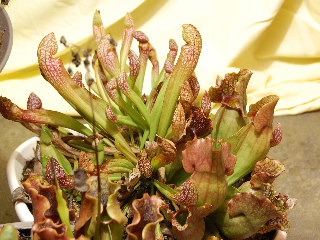
As we know, one of the miraculous and mysterious wonders of the botanical world is that plants are able to manufacture their own food by the process known as photosynthesis.
However, some plants have “figured out” a way to supplement their nutrition!
Carnivorous plants have evolved and adapted themselves to their environment in such a way as to capture animals (such as flies, etc.) to help secure some of the nutrients necessary for the continued sustenance and existence of the plants.
Carnivorous plants exist in the natural world primarily in bogs--swampy areas of wet or poorly drained soils that contain little usable nutrient matter that the plants require.
And, while growing a carnivorous plant (such as a Venus Flytrap or a Pitcher Plant) can be a great science project or a matter of scientific interest, you will need to mimic these bog-like conditions in order for your plant to live.
This means planting the carnivorous plant in a container of growing medium that can be kept moist--a mix of peat moss and perlite is a good medium.
Regular potting soil is not a good choice for your plant, as it is actually too nutrient-rich and becomes too “tight” to support the life of your carnivorous plant.
Your plant needs plentiful sunshine, too--a minimum of 6 to 8 hours of full sunlight daily.
Do not try to grow and maintain your carnivorous plant directly in your outdoor garden--you will never be able to mimic the natural bog-like conditions required by the plant of swamp-like nutrient-poor soils and full sun.
Locate your plant in a good-sized container (8” tall by 8” wide is adequate), seated in a shallow tray which will maintain your water supply to keep the growing medium constantly and evenly moist.
Being container grown allows you to locate your carnivorous plant on a sunny interior window ledge or move your plant around outdoors onto the patio or into other sites which will receive the necessary amount of sunlight.
Carnivorous plants ordered online should already be started in the proper growing medium when you receive them, so you won’t have to worry about mixing the correct ingredients to assure the health and vigor of your plant.
Sometimes, you can also purchase these intriguing plants in your garden center or at “big box” stores, particularly around holiday time as they make unusual gifts.
If you are fortunate enough to procure a carnivorous plant, don’t worry about being “devoured” by these meat-eating monsters--that’s the stuff of science fiction!
But do have fun with your interesting and unusual botanical experiment--the carnivorous plant.
 As we know, one of the miraculous and mysterious wonders of the botanical world is that plants are able to manufacture their own food by the process known as photosynthesis.
As we know, one of the miraculous and mysterious wonders of the botanical world is that plants are able to manufacture their own food by the process known as photosynthesis.